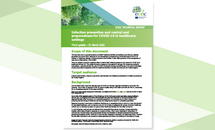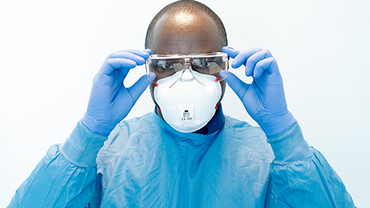Infection prevention and control and preparedness for COVID-19 in healthcare settings - sixth update
This document aims to provide guidance to healthcare facilities and healthcare providers in the European Union/European Economic Area (EU/EEA) and the United Kingdom (UK) on preparedness and infection prevention and control (IPC) measures for the management of possible and confirmed cases of COVID-19 in healthcare settings, including long-term care facilities (LTCFs). In addition, this document addresses the management of clinical diagnostic specimens at laboratories in the EU/EEA. This is the sixth update of the ECDC guidance on ‘Infection prevention and control and preparedness for COVID-19 in healthcare settings’, and replaces the document dated 6 October 2020.
Executive Summary
Key messages
Healthcare facilities, including long-term care facilities (LTCFs), should apply several types of measures to minimise the risk of transmission of COVID-19.
The mainstays of infection prevention and control (IPC) in all healthcare facilities are administrative measures, physical distancing, hand hygiene and the appropriate use of personal protective equipment (PPE).
Administrative measures decrease the opportunities for transmission within healthcare facilities and diminish the risk of outbreaks.
In areas with community transmission of COVID-19, staff, visitors and patients should apply physical distancing, hand hygiene and respiratory hygiene, and wear face masks when physical distancing is not possible.
Healthcare facilities should ensure that PPE is available and appropriately used to safeguard those providing patient and resident care. In areas with community transmission of COVID-19, frontline healthcare workers should strongly consider wearing medical face masks during all routine activities and in all communal areas.
Gloves and gowns are recommended when there is a risk of exposure to body fluids and in settings in which contamination is presumed to be high, such as where aerosol-generating procedures are performed. When used, gloves and gowns should always be changed after each patient contact.
COVID-19 cases can be released from isolation after consideration of the time from onset of symptoms, the severity of the disease, possible deficiencies of the immune system, and SARS-CoV-2 test results. There is currently insufficient evidence of prolonged viral shedding in COVID-19 cases with SARS-CoV-2 variants of concern (VOCs) to warrant stricter isolation criteria.
Due to the large impact of COVID-19 in LTCFs, it is essential that national measures are prioritised in these facilities to shield residents and prevent outbreaks.
In the European Union/European Economic Area (EU/EEA), LTCFs are often the responsibility of various national and sub-national competent authorities, usually dependent on the type of facility. Therefore, this guidance recommends activities for the most central competent public health authority. This authority should then provide guidance and support for all facilities that provide long-term care for the prevention, identification and management of COVID-19 outbreaks.
The competent health authorities should also, in collaboration with LTCFs, ensure continuity of care including maintained access to hospital healthcare; and address physical and mental wellbeing needs.
LTCFs should designate lead persons or teams to ensure accountability, resources and procedures to address: (1) IPC measures, supplies of PPE and training; (2) COVID-19 surveillance; (3) testing for SARS-CoV-2 for the timely identification and control of outbreaks; (4) access to medical and psychosocial care; and (5) visitors.
Vaccination against COVID-19 protects in varying degrees against symptomatic infection, and recent evidence also suggests varying efficacy of the vaccines in protecting against asymptomatic infection. Therefore, vaccination can be expected to have some effect on SARS-CoV-2 transmission. However, this protection is not absolute and more recent studies report reduced efficacy of COVID-19 vaccines in protecting against infection with SARS-CoV-2 VOCs, in particular the variant first identified in South Africa. As long as there is community transmission of COVID-19, it is prudent for the current guidance on self-isolation in the event of COVID-19 symptoms or proven COVID-19 and on quarantine in the event of contact with a COVID-19 case without recommended PPE to also apply to vaccinated healthcare workers.
Download

Publication data
Infographic
Infographic: Infection prevention and control in primary care
Infection prevention and control practices are of critical importance in preventing the spread of COVID-19 in primary care settings.







